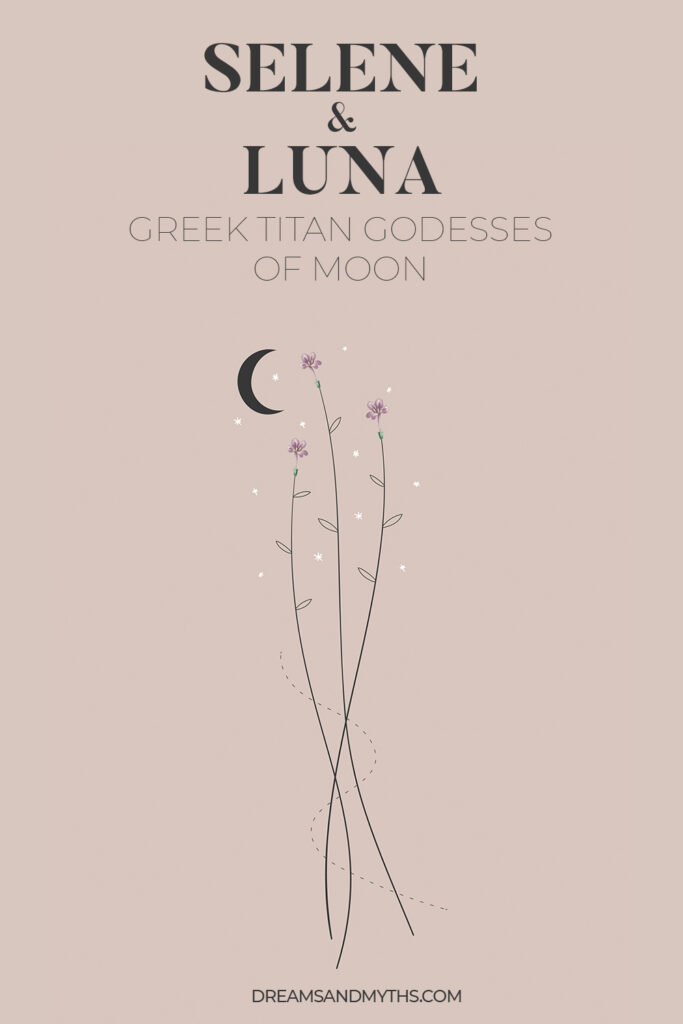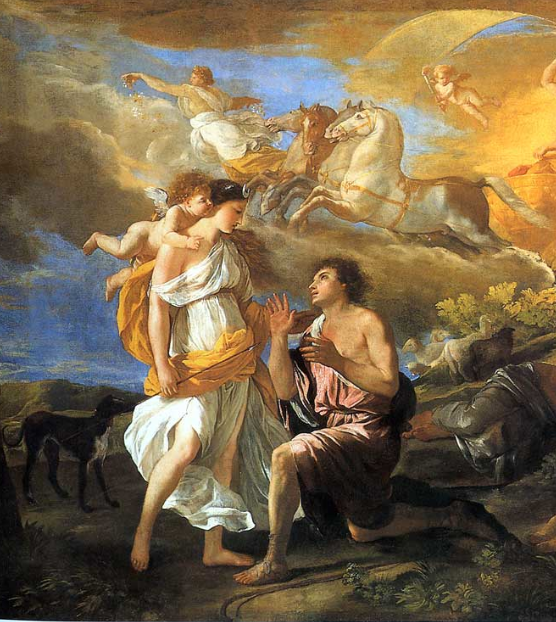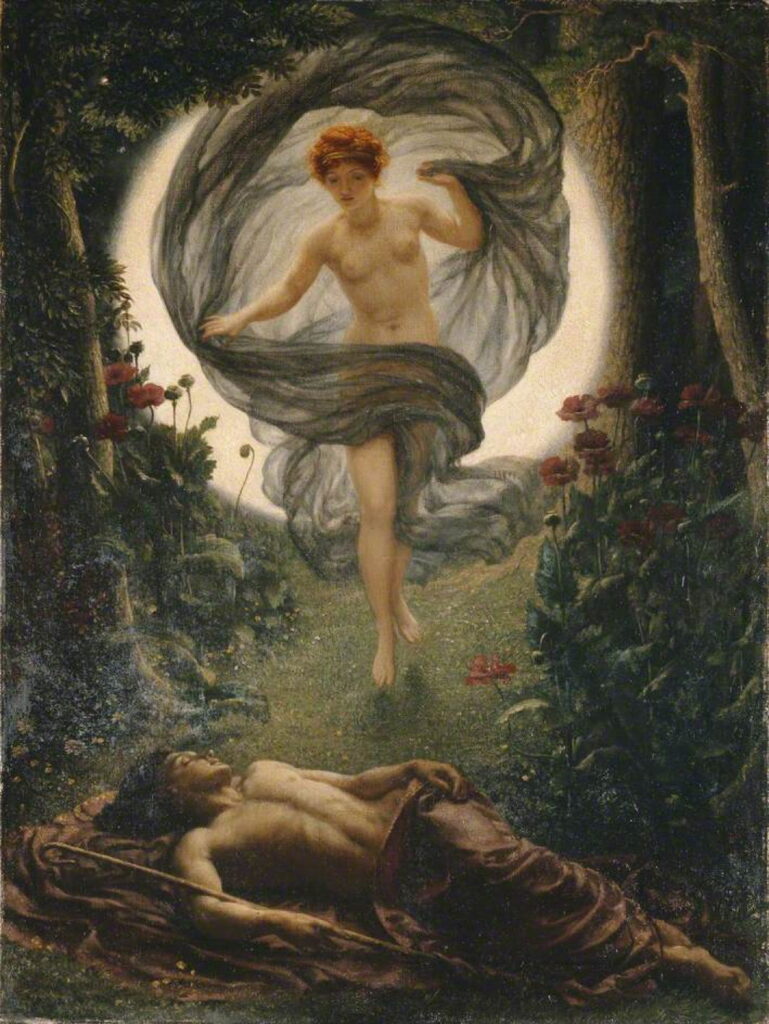Selene – or Luna as the Romans called her – is the goddess of the moon, driving a horse-drawn chariot across the night sky. Most famous classical poets describe her beauty as so intriguing that gods and mortals alike could not resist her godly charms.
Similarly, the Titan moon goddess born on the Greek isle of Rhodes had everyone wrapped around her finger with her crescent moon-shaped headdress and magnificent winged steeds carrying her around.
Although her brilliance was incomparable, not many are familiar with the goddess, especially in modern times. Her role as the incarnation of the moon is now overshadowed by the Olympian goddess of the moon, Artemis. In addition, many overlook that Selene was the moon itself while the subsequent goddesses were keepers of the moon.
Nevertheless, tales of Selene’s magnificent adventures and male consorts are plenty. Here, we will look at what makes the chariot-riding moon goddess a legend in her own right.
The Birth of Selene

1. Daughter of Hyperion and Theia
When the great Titan god of heavenly light, Hyperion, fell in love with his sister Theia, the Titan goddess of sight, the divine couple gave birth to Selene, Eos, and Helios.
Later, the children were celebrated for their radiance and godly elegance. While Eos was the god of dawn, Helios was the sun god, and Selene personified the moon.
2. Daughter of Hyperion and Euryphaessa
In a similar version recorded in The Homeric Hymn to Helios, Hyperion weds Euryphaessa (or “the widely shining”), fathering two lovely children, namely, Eos and Selene.
However, there is not much difference between this origin tale and the previous one. Hyperion espouses his sister Theia (also known as Euryphaessa) to give birth to the two powerful Titan siblings.
3. Daughter of Pallas
According to an interpretation in the Homeric Hymn to Hermes, the Titan moon goddess is the daughter of Pallas, son of the largely unknown character Megamedes.
Alternatively, Pallas was the son of Titan Crius, making him Selene’s cousin.
4. Daughter of Helios
A famous Greek tragedian, Euripides, recounted that Selene was the daughter of Helios, the most prominent sun god. This also explains why one of his epithets is Hyperion.
Although, in most versions, Helios is Selene’s brother.
Selene’s Offspring
The Titan goddess has had her fair share of children who grew to take on roles of various goddesses and other celestial beings. Below is a list of her offspring.
- Pandia: Zeus, the King of the gods, and Selene gave birth to Pandeia or Pandia Selene. She was a personification of the full moon, and the Athenian festival of Pandia is allegedly connected to her as the Athenians celebrated it on a full moon.
- Ersa: The name translating to “dew,” Ersa or Herse was the personification of morning dew. Her parents were the mighty Zeus and Selene.
- Horae: Selene gave birth to the four Horae with Helios, the sun god. Initially, the Horae were depicted as goddesses of seasons and nature. Later, they came to personify order and natural justice in the world.
- The Menai: The Menai or Menae were fifty goddesses birthed by Selene and her lover Endymion, the King of Elis, and Olympia. The fifty goddesses represented the fifty lunar months of Octaeteris, the calendar used for the ancient Olympic games.
The Moon Goddess and Her Consorts
The Greek goddess of the moon is famously known for her multiple affairs, adding to her endearing character as someone who spreads radiant love wherever she goes.
1. Endymion
One of Selene’s most popular relations was with a mortal named Endymion. Interestingly, Endymion is said to have fallen in love with the Queen of gods, Hera, much to her husband’s distaste, Zeus. As punishment, he cursed Endymion with eternal sleep.
The passionate affair between Selene and Endymion is a tale of rare female pursuit in Greek mythology. As soon as the goddess’ eyes fall on the beautiful mortal, she falls in love with him. Every day, as she rode her chariot across the sky, she would descend on the earth to admire the charming beauty that Endymion possessed.
According to some accounts, Selene’s unparalleled love for the mortal led her to ask Zeus to grant Endymion eternal sleep. In this way, she could stay with him forever.
Additionally, some others relate the tale of Endymion himself asking for eternal sleep to preserve his unrivaled beauty.
2. Pan
Pan, the Greek god of the wild, shepherds, and flocks, managed to entice the moon goddess. He accomplished this by wrapping himself in sheepskin to hide his lower body, a goat. As a result, he drew Selene down to the forests on earth, where he seduced her.
What’s more, Pan also gave her a gift of a snowy white horse. Alternatively, the god of the wild offers Selene a pair of white oxen.
3. Zeus
Not much is known about the relationship between the moon goddess and Zeus. However, we know that Zeus and Selene had an affair where they bore several godly daughters, including Naxos, Esra, Pandeia, and Nemaia.
Know More: Dive into the myths of Zeus, the god of thunder, and learn about the King, who is tremendously strong and enviable.
Legends of Selene
Even though a lesser-known goddess, the Greek goddess of the moon has many tales about legendary wars, dangerous curses, and other odd titbits added to her name.
Some of our unique goddesses’ exciting stories are listed below.
1. Gigantomachy
Selene was crucial in the infamous war between the Giants and the Olympian gods. When Gaia, the Earth goddess, heard about her children, the Titans, being imprisoned by the gods, she ordered the Giants to attack them in revenge. The resulting war was called Gigantomachy.
According to a prophecy, a mortal was destined to help the gods defeat the Giants. So, Gaia sought a herb that would make her army of Giants undefeatable. On hearing this, Zeus asked Selene and her sibling (Helios and Eos) not to shine.
As the Sun and the moon refused to rise, Zeus took the opportunity to harvest all herb plants for the gods.
2. Typhon, the Giant
When Typhon, the enormous serpentine monster, lay siege to the sky, he attacked Selene by flinging bulls at her. But she managed to keep on course and raced at him hissing like a snake.
Selene battled back the giant, squaring up against Typhon. As a result, scars from their fight covered her body completely.
3. Ampelus, the Vain
Ampelus was a young satyr adored by the deity Dionysus. According to an account by the epic poet Nonnus, Ampelus rode a bull and constantly compared himself to Selene. He claimed that he had horns and rode bulls much like her, making himself Selene’s equal.
Enraged, Selene sent a gadfly to sting the bull Ampelus rode on. And on being stung, the bull flung Ampelus off in a panic, goring him to death afterward.
4. The Nemean Lion
In Greek mythology, the Nemean Lion was a monstrous creature known for having unique fur that made him undefeatable. Often, Selene is said to be involved in rearing the Nemean Lion stating, “The lion fell from the moon” on several accounts.
Further, some tales say that Hera collaborated with Selene by performing magical incantations to birth the Lion from a chest full of foam.
But, some more popular myths attribute Nemean Lion to Orthrus and the Chimera, only to be raised by Hera later.
5. Muia, the Insolent Young Girl
Some authors also recall an otherwise undocumented legend. A lovely young lady named Muia competes with Selene for Endymion’s affections. This lively maiden would talk to him nonstop while he slept, waking him up.
Endymion was upset, and Selene became outraged, turning the girl into a fly. The fly still bothers all sleeping people in remembrance of the lovely Endymion.
6. Basileia
According to a lesser-known narrative, Basileia succeeded her father, Uranus, to the throne. She wedded her brother Hyperion and had Helios and Selene’s daughter. Mortals and gods alike immensely praised the children for their attractiveness and virginity.
Basileia’s brothers envied Hyperion and his children, worried that he would try to capture all the kingdom’s power for himself. Thus, they plotted against him. They slew Hyperion with a sword and drowned Helios in the Eridanus River. On hearing this, Selene committed suicide.
Later, Hyperion appears in their mourning mother’s dreams, assuring her that he and his sister have peacefully converted into divine natures.
7. Tale of the Un-fitted Dress
One unusual tale by the great poet Plutarch relates how Selene once begged her mother to sow a dress to fit her perfectly.
Unfortunately, her mother could not fulfill her request since the Greek goddess of the moon constantly changed forms from being full-sized, sometimes crescent-shaped, and then half her size.
8. Wiping Out All Philosophers from Earth
In the tale Icaromenippus, Selene complains to Menippus about philosophers’ ridiculous claims about her. These included why she is always waxing or gibbous, populated, and getting her stolen light from the Sun. Thus, causing strife and ill feelings between her and her brother.
She requests that Menippus convey her problems to Zeus and that Zeus erase all-natural philosophers off the face of the planet. Zeus accepts, prompted by Selene’s objections and having planned to deal with the philosophers personally for a long time.
The Cult of Selene

According to researchers who studied the Titans, some of the rites and myths linked with gods and goddesses like Selene arose to promote old shamanistic activities. Additionally, in antiquity, mystery cults were shrouded in secret only existing so that people could perform rites of birth and death.
Read More: Shamanism has existed since a long time ago. Read about the evolution and rituals of shamanic traditions.
It’s also worth noting that Selene and Artemis (goddess of the hunt) are frequently confused as the same deity. As a result, Selene’s rituals often coincided with the goddess of the hunt, though she remains a moon goddess forever.
Moreover, moon motifs have been found on Cretan rings and jewels (perhaps suggesting a Minoan moon cult). Still, aside from the moon’s importance in magic, mythology, and poetry, Selene received comparatively little attention. Some of the hints of worship of the Greek goddess are:
- An oracular sanctuary near Thalamai in Laconia contained statues of Helios and Pasiphae. Here, Pasiphae was a reference to an epithet of Selene. Other stone structures depict the moon goddess with prominent crescent moon horns on her head.
- Pandia (or Pandia Selene) personified the full moon. Therefore, an Athenian festival named Pandia, commonly thought to be a Zeus festival, may have been held on the full moon and linked with Selene.
- Selena and several other heavenly gods like Helios and Eos were presented with wineless gifts in Athens.
- Moreover, Selene played an essential role in sewing magic and love together. Some narratives mention how lovesick women would pray to Selene for help and guidance to pursue their lovers.
- Selene was sometimes associated with childbirth. It was believed that women had the easiest labors during the full moon; this aided in her association with the goddess Artemis and other deities involved with women in labor.
Luna: The Roman Goddess of Moon

Selene became Luna when her Greek identity evolved into her Roman one. She is frequently shown as the feminine counterpart to the Sol, the sun deity.
With Diana and Hecate, Luna is an occasional part of the Roman triple goddess (diva triformis). Luna’s most prominent features in Roman art are the crescent moon and the two-yoke chariot called biga. She is also referred to as the two-horned Queen of the stars in the Carmen Saeculare by Horace.
Contrary to the status of Selene in Ancient Greece, Luna was categorized amongst the more visible gods in Roman mythology. Some poets regarded her as the sacred guardian and guarantee of peace in the Roman Empire.
Bonus Read: Explore how the Romans built upon the Greek traditions to create Roman mythology myths and folklore.
Luna’s Symbolism
In ancient Rome, the moon and its related cult of Luna were undeniably powerful symbols of the agricultural cycle. It symbolizes how all that dies will be reborn just as seeds germinate and develop.
In addition to femininity, childbirth, and agriculture, the moon regulated many other aspects of sublunar life, including the wind, rain, tides, animal life, mineral development, and earthquakes.
Verdict
In both mythologies, Selene and her Roman counterpart, Luna, are mighty goddesses. Their calm power reflects in the depictions of the goddess of the moon in various pieces of literature.
The Greek and Roman societies thrived on glorifying gods and maintaining human-god relations. Within such a framework, goddesses like Selena and Luna gained importance by personifying essential aspects of human life on earth, like the moon, fertility, and femininity.
